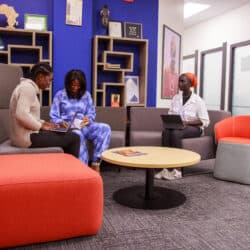Where should work happen, and when? For how many hours? Post-pandemic, our assumptions about the nature of work have been turned upside down. Contributor Yvonne Rodney outlines the many questions the new zeitgeist has raised and talks to three sector leaders about the practices and changes their organizations have put in place to try to tackle these challenges.
In the previous installment of the Work in Progress series, we examined the impact of the pandemic on volunteer involvement and reengagement. Now we spotlight the nature of work itself and some of the tensions with which organizations are grappling.
During the pandemic, humanity en masse stared mortality in the face. Priorities shifted and reconvened a new zeitgeist. With this shift, everything we took for granted about the nature of work is being brought into question.
Where should work happen? When should work happen? For how many hours should we work? These are just a few of the questions and trends organizational leaders are grappling with in the current employee-driven job market.
Where people work
Pre-pandemic work, for the most part, took place in offices or buildings where employers and employees congregated daily to work toward a common goal. All that changed as a result of the pandemic. It forced organizations to pivot to virtual connections, secure meeting platforms, and creative ways to engage with clients and colleagues – remotely. Now, employers expecting or insisting that workers return to the office full-time are meeting with resistance. Many employees have no desire to return to the days of long commuting. In fact, employees want to be doing less or no commuting at all. In addition, rising costs for food, housing, and transportation add to the pressure to push for alternate work solutions.
This leads to even more questions:
- Is remote work the solution? What about work that cannot be done remotely?
- What is an employer to do when they are locked into a long-term lease agreement signed prior to the pandemic?
- What about employees who cannot work from home because it is neither safe nor viable?
- What about liability issues associated with employees working from home?
No matter the side one argues, for or against, hybrid work solutions are not going away. So how can things like accountability, monitoring, staff interaction, and the way business was run prior to the pandemic happen differently? How can remote work, work well?
When people work and for how long
Henry Ford is credited with instituting the 40-hour, five-day workweek at his automotive production plant. By the 1940s, this was the norm for North America and governs how most organizations operate to this day. But during the height of the pandemic, as remote work gained momentum, much was written questioning the relevance of a 40-hour workweek. One article described it as outdated and destructive. Proponents called on governments to consider a four-day workweek. Affected business leaders argued against its feasibility.
This leads to even more questions:
- What are the organizational implications if a shorter workweek is instituted?
- Can workers be given the flexibility to work when it works for them and not within designated time windows?
Oh, that the solutions were simple. Fix this or do that and … voilà!
But to get to the answers, we have to also examine the beliefs, assumptions, and preferences we’ve internalized about how work should be done and how current expectations are challenging these beliefs. This requires some navel-gazing – both personal and societal:
- What do I believe about work?
- Where did this belief originate?
- How do I expect employees to behave in their relationship with me, the work they are contracted to do, and in relation to their colleagues?
- What is my leadership style or preference? When did I internalize this preferred style? Does it still work?
And an even more aggravating question: am I prepared to change?
Every question posed leads to others:
- How do we keep workers accountable?
- How do we ensure productivity remains high and consistent with our organizational values?
- Is productivity a necessary or desired end goal for non-profits and charities?
- What must we change to remain relevant and retain great people within our organizations?
Tension rules the day. However, if we pay attention to the tension, it will cause us to seek treatment. We stretch, breathe through the pain, and eventually discover that we have arrived at a place of increased flexibility.
There is no magic bullet. But as we strive to find answers, we can remember that we have the capacity to be creative. The pandemic showed us that we could. We can look beyond what we are doing and ask for help. We can, as a sector, work collectively toward solutions for our sector, by our sector, that align with our missions and values.
To this end, we asked the leaders of three organizations – Impact Organizations of Nova Scotia, the Lawson Foundation, and FoodShare – how they are tackling some of these challenges.
Impact Organizations of Nova Scotia
Staff retention/burnout
Annika Voltan, executive director of Impact Organizations of Nova Scotia (IONS), believes the non-profit sector is hitting a critical point when it comes to issues of staff retention, burnout, wages, and benefits. Very few offer health benefits, retirement plans, or parental leave top-ups in a workforce that is predominantly female. “If we don’t start to shift the amount of work and the priorities, we are not going to make headway in the burnout issue, especially when demand for services is increasing.”
Where people work
Voltan identifies with some of the tensions that remote working can create. She believes that for remote working (hybrid or exclusively) to work, organizations need a solid accountability system in which roles are clarified, work planning is a must, and both employee and employer are working toward a shared purpose. She adds that remote work can also offer a safer environment for marginalized staff members who daily experience micro-aggression in the workplace.
Work monitoring/trust/accountability
Voltan believes that different management styles, intergenerational differences, individual worldviews, and a host of other factors influence how we deal with trust. She offers a hypothetical example: Let’s say a staff member is supposed to be in the office on a particular day or working from home. The employer is not able to get hold of them and they are not responding to messages. What, then, does an employer do if they don’t trust that staff are working when they should be?
“I have shared with my team the ‘Anything goes, come in when you feel like it’ tension and that I struggle with it,” Voltan says. For her, the solution is to have an underlying system in place that focuses on outcomes. “If our staff does not know in clearly stated terms what the expectations are, how can they meet them?” She believes openness and transparency is key to communication and building trust. Thus, a conversation with the staff member could look like this:
Employer: “When you don’t answer for three hours, I don’t know where you are.”
Worker: “When I get into a workflow and I am distracted by messages, it affects my ability to get things done, so I have to go offline.”
Voltan’s experience is that once she has this type of discussion with a team member, the behaviour initially perceived as “unresponsive” often links to mental health and neurodiversity issues – and very rarely to staff goofing off.
Governance
Voltan sees non-profits using “for profit” principles and methods in how they operate and questions why this is so, when profit-making is not our end goal. She challenges non-profits and charities to explore other ways of working where knowledge is shared differently. She identifies capitalistic language and colonialist ideologies at the root of how we govern and thinks that by examining our views, we can arrive at different ways of working that get us closer to the outcomes and values alignment we desire.
Here are some of the practices/planned changes at IONS:
- Moved to a four-day, 32-hour workweek but kept pay the same. For employees, it felt like getting a 20% increase while offering them the flexibility to take another part-time job or do something else with the time.
- Moving away from an urgency culture and focusing on high impact work.
- Established a peer network group, ED Connections, to facilitate peer-to-peer learning, discussion of pressing issues, collaboration, and relationship development for and among leaders within Nova Scotia’s community impact sector.
- Developing a “community of practice” aimed at decolonizing workplace culture and creating nurturing and welcoming workspaces.
- This community of practice is a living JEDDI (justice, equity, diversity, decolonization, and inclusion) lab “with a goal of decentralizing decision-making and feedback processes, ensuring everyone has role clarity/purpose and a sense of autonomy, and prioritizing flexibility and different ways of working.” Meetings are held biweekly (with longer retreats as needed), and this living lab is serving as a place to experiment and share learning with others in the sector.
Lawson Foundation
Where people work
Marcel Lauzière, president and CEO of the Lawson Foundation, sees the “where people work” question as a non-issue as it pertains to his organization’s work. “It’s a results issue,” he says. “Whether people go into an office or not, can they produce the results we want?”
When the pandemic forced closures of office buildings, the Lawson Foundation was not affected because it was already set up for remote work. In addition, employees have liability coverage for injuries that happen at home. Lauziere believes that “as a good employer, we should do that.”
Work monitoring/trust/accountability
The Lawson Foundation is premised on a “results-only work environment” (ROWE) model: rather than look at where people are working, when they are working, and for how many hours, one strictly looks at the results. Each employee receives and cosigns a clear letter of expectation from the CEO regarding goals and objectives for the year. Biweekly and quarterly reviews are in place to allow for changes or adjustment to goals. Every Monday, staff members update each other on priorities for the week to get a sense of what others are working on and to create alliances if and where needed.
Lauzière admits that for the ROWE method to work, you have to hire self-starters – people who are comfortable working in a self-managed way and excellent communicators. He suspects that people who need structure in their days and feel they work better with others around them (the other side of the autonomy piece), and those for whom it is difficult at home or who need to get out of their home environment, may not do so well with a ROWE approach.
Staff retention/burnout
Lauzière believes that having “the flexibility to work when it works best for you is a big factor in well-being” and that people with low flexibility are more stressed out. Flexibility also democratizes the workplace. So, to keep staff mentally healthy, Fridays are designated for uninterrupted work at the foundation.
Lauzière notes that the Lawson Foundation hired staff during the pandemic who don’t know any other way of working with the organization except remotely. He thinks there is now an opportunity to reconnect and build community in a way that is “new and quite special.”
Not a one-size-fits-all
Lauzière admits that the ROWE model is not for everyone – that it works best for organizations that are knowledge-based.
Here are some of the practices/changes at the Lawson Foundation:
- The ROWE model guides how they work.
- Each staff member (team of seven) provides Monday morning updates on priorities for the week.
- Fridays are designated as days for uninterrupted work (i.e., no meetings).
- Each staff member is provided clearly stated goals and regular check-ins so that adjustments can be made as needed.
- Hiring is done strategically for staff who will fit into Lawson’s work culture.
FoodShare
FoodShare is often held up as a model of a progressive non-profit work culture. Julie Fiorini, acting executive director and director of development and communications, describes the organization’s goal as that of working toward a Toronto “where all people can feed themselves, their loved ones, and their communities with dignity and joy.” FoodShare is involved in a variety of community-based initiatives across the city, including markets that offer affordable and culturally appropriate fresh food, workshops, and educational programs that support food justice.
Since their inception in the mid-1980s, they have strategically put policies and practices in place to align with their organizational values. Fiorini gives some examples:
- All workers are paid (no volunteers).
- Every employee is guaranteed a living wage (currently pays $2 above living wage).
- Salaries are non-negotiable and the salary grid is transparent.
- All staff get four weeks’ vacation.
- On top of a two-week (paid) winter shutdown, workers are eligible for 20 wellness days and 10 personal days, along with RSP and EAP benefits.
- A strict email policy is in place, with emails sent only between 9 a.m. and 5 p.m.
- No meetings are scheduled and no emails are sent during the noon to 1 p.m. lunch break.
- They are testing the idea of holding no meetings between 9 a.m. and 1 p.m. on Wednesdays.
- They are exploring opportunities to sublet space not being used or partnering with other organizations.
- To recognize and value the time it takes to come in for interviews, Foodshare pays a $75 stipend to all interviewees regardless of the role being interviewed for.
It’s clear from these three examples that there is no standard blueprint. Every non-profit or charity must find the solutions that work for the work it does.
As non-profit leaders and team members, we need to have candid conversations. Discuss, get vulnerable, push, stretch, and push some more. Let us learn lessons about our beliefs, our assumptions, and ourselves. Let’s engage our teams in coming up with solutions that will work for us. Let’s consult with other cultures, explore other paradigms, topple some sacred personal icons, and embrace, if needed, new ways to work even better. Perfection is not the end goal. It’s the striving for and adjusting to and keeping human sustainability at the heart of all solutions that will get us to the other side of now.
In the next installment of Work in Progress, we would love to highlight some of the small or radical changes your organization is employing as you adjust to the new workplace realities. We invite you to share with us what you are doing.
The Work in Progress series is being developed in collaboration with the following content development partners: the Future Skills Centre, the Counselling Foundation of Canada, CERIC, Imagine Canada, the Ontario Nonprofit Network, and the Workforce Funder Collaborative.


